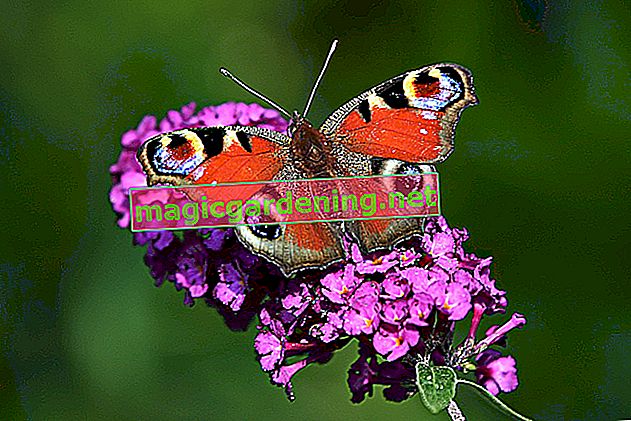
Name and family
The peacock butterfly has the scientific name Aglais io. The butterfly comes from the noble butterfly family.
also read
- Peacock butterfly lifespan - that's how long it is granted
- The peacock butterfly has a large habitat
- The daffodil - profile of a spring messenger
Different stages of development
The peacock butterfly goes through various stages of development. A caterpillar hatches from an egg, which pupates after a few weeks and turns into a butterfly. It hibernates over the winter and mates the following spring. This closes the cycle.
Appearance of the eggs
- each butterfly lays 50 to 150 eggs
- previously only in May or June, now a second time in September
- Storage space is the underside of nettle leaves
- each egg is about 1mm small and greenish in color
- with eight white longitudinal ribs
- after two weeks the caterpillars hatch
The caterpillars
- are initially only 3 mm long
- they are white-greenish, have a black head
- feed on nettle leaves
- live together
- shed their skin after a few days
- then turn gray-brown
- further moults follow
- after 3-4 weeks they are fully grown
- are then up to 42 m long
- have black bodies with white spots and black thorns
- pupation follows soon
Adult butterfly
The butterfly hatches after about two weeks. He inflates his wings with air and blood so that they harden and he can fly. The wings have a distinctive pattern that makes the precious butterfly unmistakable.
- have a rust-red hue
- there is a colored eye on each wing tip
- The undersides of the wings are gray with black marbling
- Wingspan is 50 to 55 mm
Note:
If the wings are closed, the peacock butterfly can be mistaken for a dead leaf. Spreading the wings, on the other hand, can drive away possible predators, because the patterns are perceived as the eyes of a larger animal.
lifespan
The adult butterfly lives for a year, often two. The climatic conditions and how well the butterfly can overwinter are decisive for the lifespan. To do this, he visits caves or human habitation, among other things. The place must be frost-free but below 12 ° C. Then you lapse into paralysis.
habitat
The butterfly is native to Europe and Asia, with the exception of Greece, parts of the Iberian Island and areas not far from the North Pole, e.g. B. Northern Scandinavia. It lives up to an altitude of 2,500 m.
The peacock butterfly can be found in light, sunny forests or on colorful meadows. But it also finds suitable habitats in settlement areas. This butterfly can be seen in parks, cemeteries and in private gardens.
food
While the caterpillars feed exclusively on the nettle plant, adult butterflies can fly to various flowers and suck their nectar, although they seem to have a preference for purple flowers. Thistles, blue pillows, buddleia, dahlias, vetch or thyme are popular among others. In spring, the willow, also called pussy willow, is the first to attract.
Predators
The peacock butterfly also has predators. These are other insects and some species of birds.








